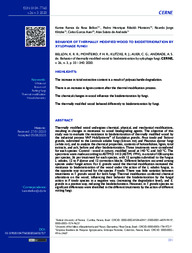Behavior of thermally modified wood to biodeterioration by xylophage fungi.
Behavior of thermally modified wood to biodeterioration by xylophage fungi.
Author(s): BELLON, K, R. da R.; MONTEIRO, P. H. R.; KLITZKE, R. J.; AUER, C. G.; ANDRADE, A. S. de
Summary: Thermally modified wood undergoes chemical, physical, and mechanical modifications, resulting in changes in resistance to wood biodegrading agents. The objective of this study was to evaluate the resistance to biodeterioration of thermally modified wood by the industrial process VAP HolzSysteme® of Eucalyptus grandis, Pinus taeda and Tectona grandis, submitted to the Lentinula edodes fungi (brown rot) and Pleurotus djamor fungi (white rot), and to analyze the chemical properties, contents of holocellulose, lignin, total extracts, and ash, before and after biodeterioration. Three treatments were considered for each species: Control - wood in natura, modified wood at 140 °C and 160 °C. The specimens were made according to ASTM D 1413 (ASTM, 1994), in a total of 108 samples per species, 36 per treatment for each species, with 12 samples submitted to the fungus L. edodes, 12 to P. djamor and 12 correction blocks. Different behaviors occurred among species under fungal action. For E. grandis wood the thermal modification increased the resistance to biodeterioration of the wood under the action of the L. edodes fungus, in the opposite way occurred for the species P. taeda. There was little variation between treatments in T. grandis wood for both fungi. Thermal modification conferred chemical alterations on the wood, influencing their behavior the biodeterioration by the fungal action in P. taeda species in a negative way, (increasing the degradation level), and E. grandis in a positive way, reducing the biodeterioration. However, in T. grandis species no significant differences were identified in the different treatments by the action of different rotting fungi.
Publication year: 2020
Types of publication: Journal article
Unit: Embrapa Forestry
Observation
Some of Embrapa's publications are published as ePub files. To read them, use or download one of the following free software options to your computer or mobile device. Android: Google Play Books; IOS: iBooks; Windows and Linux: Calibre.
Access other publications
Access the Agricultural Research Database (BDPA) to consult Embrapa's full library collection and records.
Visit Embrapa Bookstore to purchase books and other publications sold by Embrapa.

